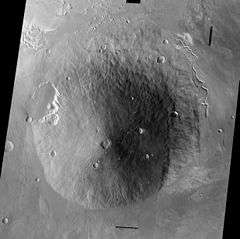Elysium (volcanic province)
|
Colorized topographic map of Elysium and its surroundings, from the MOLA instrument of Mars Global Surveyor. The shield volcano Elysium Mons is at center, with the smaller volcanoes Hecates Tholus and Albor Tholus to its upper and lower right, respectively. | |
| Coordinates | 24°42′N 150°00′E / 24.7°N 150.0°ECoordinates: 24°42′N 150°00′E / 24.7°N 150.0°E |
|---|---|
Elysium, located in the Elysium and Cebrenia quadrangles, is the second largest volcanic region on Mars, after Tharsis.[note 1] The region includes the volcanoes (from north to south) Hecates Tholus, Elysium Mons and Albor Tholus. The province is centered roughly on Elysium Mons at 24°42′N 150°00′E / 24.7°N 150°E. Elysium Planitia is a broad plain to the south of Elysium, centered at 3°00′N 154°42′E / 3.0°N 154.7°E.[2] Another large volcano, Apollinaris Mons, lies south of Elysium Planitia and is not part of the province. Besides having large volcanoes, Elysium has several areas with long trenches, called fossa or fossae (plural) on Mars. They include the Cerberus Fossae, Elysium Fossae, Galaxias Fossae, Hephaestus Fossae, Hyblaeus Fossae, Stygis Fossae and Zephyrus Fossae.
Volcanoes of Elysium
-

High-resolution THEMIS daytime infrared image mosaic of Elysium from 2001 Mars Odyssey.
-

MOLA maps showing the geographic context of Elysium.
-

Hecates Tholus, as seen by THEMIS.
-

Albor Tholus, as seen by THEMIS.
Troughs (fossae) in Elysium
-
Troughs to the east of Albor Tholus, as seen by HiRISE under the HiWish program.
-
Portion of a trough (fossa) in Elysium, as seen by HiRISE under the HiWish program. Blue indicates probably seasonal frost.
-
Cerberus Fossae, as seen from THEMIS.
-
Cerberus Fossae, with emission of dark material, as seen by HiRISE. Narrow band of material is coming out of the trough. Scale bar is 500 meters long.
-
Cerberus Fossae, as seen by HiRISE.
-
Elysium Fossae, as seen by HiRISE. Click on image to see layers.
-
Two views of the Hephaestus Fossae, as seen by HiRISE. Picture on right lies to the top (north) of other picture. Fossae often form by material moving into an underground void.
See also
Notes
References
- ↑ "Elysium". Gazetteer of Planetary Nomenclature. USGS Astrogeology Science Center. Retrieved 2013-11-29.
- ↑ "Elysium Planitia". Gazetteer of Planetary Nomenclature. USGS Astrogeology Science Center. Retrieved 2013-11-29.
External links
- Google Mars - zoomable map centered on Elysium Planitia, with three main volcanoes of Elysium visible
- google mars - Cerebrus Fossae fissures
